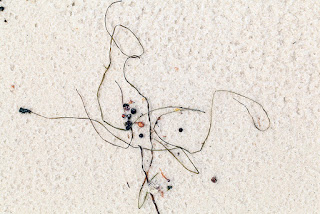Despite the contrasts, the heat of summer brings to mind enticing visions of cool water. Down here we have rivers with tannin dark waters and pristine beaches of white sand, rounded grey granite washed by cold azure seas. Up north, the beaches are washed by warm waters that can disappear into the distance with the huge tides, and the inland pools have fish lurking in the shadows, visible if you are still and quiet. In the wet after a good cyclone there can water as far as the eye can see.
It is those inland pools that remind me of the work of Sonia Kurarra. We saw some of her paintings when we were last in Perth at Form Gallery and it was great to see her work up close as I had only seen digital images previously. Her colours are rich with the reds of her homeland and vibrant contrasts. Nothing says sweltering humid summer more to me than shimmering hot pink and orange red. Barramundi appear and disappear within her expressive brushstrokes.
 |
| The river near Noonkanbah (Yungngora) |
Kurarra is from the country around Noonkanbah (Yungngora) and the Fitzroy River in the Kimberley region of Western Australia, not too far from Broome. She paints the billabong country of the Fitzroy, and the fish - barramindi (parlka) and catfish (kurlumajarti) - that are important food species. Other themes that she paints are also related to traditional life; the rocks where the fish is cooked (parrmarr), coolamon for carrying things (ngurti) and boomerang (karli).
 |
| Barramundi dreaming |
In 2010 Kurarra won the Western Australian Indigenous Art Award and the port Hedland indigenous art award. This year she won the Most Outstanding Work at the Port Hedland Art Awards for her work Martuwarra (Kurarra's river country).
| Parlka (Barramundi) and rockholes 2010 |















































